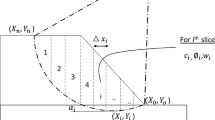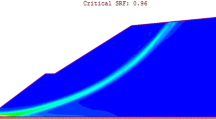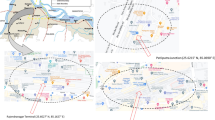Abstract
This study overviews how to strengthen railway embankments using a geo-grid in the cohesive soil embankment layer and the Bishop method to determine a safety factor using Geo-Studio software. The primary goal of this study is to show the relationship between an embankment’s safety factor with and without a geo-grid. These parameters, such as angle of internal friction, cohesion value, and unit weight for both the subsoil and embankment layer, respectively, pull-out resistance, and tensile capacity for geo-grid, have been used as input in this test. The safety factor has increased continually after altering its features and incorporating a geo-grid into the embankment layer. Based on the Geo-Studio results, the ideal choice was to strengthen the railway embankment by adding a geo-grid to the embankment layer and employing a reliable computational technique to analyse the corridor’s probabilistic slope stability for heavy-duty freight trains. The current method, which has been utilised to undertake a probabilistic study of a high embankment of 12.29 m taken by the Ministry of Indian Railways for a heavy-haul freight corridor, consists of four model analyses: convolutional neural networks (CNN), deep neural networks (DNN), artificial neural networks (ANN), and multiple linear regression (MLR). Performance indicators assessed the models’ performance, such as R2, RMSE, RSR, WI, MAE, NS, and PI. According to the analysis of the results, the CNN model outperformed DNN, ANN, and MLR. CNN is, therefore, a trustworthy soft computing technique for determining the safety of a railway embankment slope.













Similar content being viewed by others
Data Availability
The author confirms that the data supporting the findings of this study are available from the corresponding author upon reasonable request from the reader.
References
Abdi, M.R., Sadrnejad, A., Arjomand, M.A.: Strength enhancement of clay by encapsulating geogrids in thin layers of sand. Geotext. Geomembranes. 27, 447–455 (2009)
Afrazi, M., Yazdani, M.: Determination of the effect of soil particle size distribution on the shear behavior of sand. J. Adv. Eng. Comput. 5, 125–134 (2021)
Ahmad, F., Samui, P., Mishra, S.S.: Probabilistic analysis of slope using Bishop method of slices with the help of subset simulation subsequently aided with hybrid machine learning paradigm. Indian Geotech. J. 1–21 (2023)
Assefa, E., Lin, L.J., Sachpazis, C.I., Feng, D.H., Shu, S.X., Xu, X.: Slope stability evaluation for the new railway embankment using stochastic finite element and finite difference methods. Electron. J. Geotech. Eng. 22, 51–79 (2017)
Baecher, G.B., Christian, J.T.: Reliability and statistics in geotechnical engineering, John Wiley & Sons (2005)
Bardhan, A., Manna, P., Kumar, V., Burman, A., Žlender, B., Samui, P.: Reliability analysis of piled raft foundation using a novel hybrid approach of ANN and equilibrium optimizer. Comput. Model. Eng. Sci. 128 (2021). https://doi.org/10.32604/cmes.2021.015885
Bardhan, A., Samui, P.: Probabilistic slope stability analysis of heavy-haul freight corridor using a hybrid machine learning paradigm. Transp. Geotech. 37, 100815 (2022). https://doi.org/10.1016/j.trgeo.2022.100815
Bergado, D.T., Sampaco, C.L., Shivashankar, R., Alfaro, M.C., Anderson, L.R., Balasubramaniam, A.S.: Performance of a welded wire wall with poor quality backfills on soft clay. In: Geotech. Eng. Congr., pp. 909–922 (1991)
Bishop, A.W.: The use of the slip circle in the stability analysis of slopes. Géotechnique. 5, 7–17 (1955). https://doi.org/10.1680/geot.1955.5.1.7
Cao, Z., Wang, Y., Li, D.: Probabilistic approaches for geotechnical site characterization and slope stability analysis, Springer (2017)
Chen, H.-T., Hung, W.-Y., Chang, C.-C., Chen, Y.-J., Lee, C.-J.: Centrifuge modeling test of a geotextile-reinforced wall with a very wet clayey backfill. Geotext. Geomembranes. 25, 346–359 (2007)
Cho, S.E.: Probabilistic stability analyses of slopes using the ANN-based response surface. Comput. Geotech. 36, 787–797 (2009)
Das, B.M., Khing, K.H., Shin, E.C.: Stabilization of weak clay with strong sand and geogrid at sand-clay interface. Transp. Res. Rec. 1611, 55–62 (1998)
Das, G., Burman, A., Bardhan, A., Kumar, S., Choudhary, S.S., Samui, P.: Risk estimation of soil slope stability problems. Arab. J. Geosci. 15, 1–16 (2022)
Démurger, S.: Infrastructure development and economic growth: an explanation for regional disparities in China? J. Comp. Econ. 29, 95–117 (2001)
Deng, J.: Structural reliability analysis for implicit performance function using radial basis function network. Int. J. Solids Struct. 43, 3255–3291 (2006)
Deng, J., Gu, D., Li, X., Yue, Z.Q.: Structural reliability analysis for implicit performance functions using artificial neural network. Struct. Saf. 27, 25–48 (2005)
Faure, Y.H., Baudoin, A., Pierson, P., Plé, O.: A contribution for predicting geotextile clogging during filtration of suspended solids. Geotext. Geomembranes. 24, 11–20 (2006). https://doi.org/10.1016/j.geotexmem.2005.07.002
Giroud, J.P.: From geotextiles to geosynthetics: a revolution in geotechnical engineering--3rd International Conference on Geotextiles (1986)
Golafshani, E.M., Behnood, A., Arashpour, M.: Predicting the compressive strength of normal and High-Performance Concretes using ANN and ANFIS hybridized with Grey Wolf Optimizer. Constr. Build. Mater. 232, 117266 (2020). https://doi.org/10.1016/j.conbuildmat.2019.117266
He, X., Xu, H., Sabetamal, H., Sheng, D.: Machine learning aided stochastic reliability analysis of spatially variable slopes. Comput. Geotech. 126, 103711 (2020)
Huang, Y., Chen, C., Su, D., Wu, S.: Comparison of leading-industrialisation and crossing-industrialisation economic growth patterns in the context of sustainable development: lessons from China and India. Sustain. Dev. 28, 1077–1085 (2020)
KabongoBooto, G., Run Vignisdottir, H., Marinelli, G., Brattebø, H., Bohne, R.A.: Optimizing road gradients regarding earthwork cost, fuel cost, and tank-to-wheel emissions. J. Transp. Eng. Part A Syst. 146, 4019079 (2020)
Kumar, V., Samui, P., Himanshu, N., Burman, A.: reliability-based slope stability analysis of Durgawati Earthen Dam considering steady and transient state seepage conditions using MARS and RVM. Indian Geotech. J. 49, 650–666 (2019). https://doi.org/10.1007/s40098-019-00373-7
Kumar, D.R., Samui, P., Burman, A., Wipulanusat, W., Keawsawasvong, S.: Liquefaction susceptibility using machine learning based on SPT data. Intell. Syst. with Appl. 20, 200281 (2023)
Le, L.T., Nguyen, H., Dou, J., Zhou, J.: A comparative study of PSO-ANN, GA-ANN, ICA-ANN, and ABC-ANN in estimating the heating load of buildings’ energy efficiency for smart city planning. Appl. Sci. 9, 2630 (2019)
Majedi, M.R., Afrazi, M., Fakhimi, A.: A micromechanical model for simulation of rock failure under high strain rate loading. Int. J. Civ. Eng. 19, 501–515 (2021)
Phoon, K.-K., Ching, J.: Risk and reliability in geotechnical engineering. CRC Press, Boca Raton (2015)
Pradhan, B., Chaudhari, A., Adinarayana, J., Buchroithner, M.F.: Soil erosion assessment and its correlation with landslide events using remote sensing data and GIS: a case study at Penang Island, Malaysia. Environ. Monit. Assess. 184, 715–727 (2012). https://doi.org/10.1007/s10661-011-1996-8
Raja, M.N.A., Shukla, S.K.: An extreme learning machine model for geosynthetic-reinforced sandy soil foundations. Proc. Inst. Civ. Eng. Eng. 1–21 (2020)
Raja, M.N.A., Shukla, S.K.: Multivariate adaptive regression splines model for reinforced soil foundations. Geosynth. Int. 1–23 (2021)
Raja, M.N.A., Shukla, S.K., Khan, M.U.A.: An intelligent approach for predicting the strength of geosynthetic-reinforced subgrade soil, Int. J. Pavement Eng. 0, 1–17 (2021). https://doi.org/10.1080/10298436.2021.1904237.
Raja, M.N.A., Shukla, S.K.: Predicting the settlement of geosynthetic-reinforced soil foundations using evolutionary artificial intelligence technique. Geotext. Geomembranes. (2021a). https://doi.org/10.1016/j.geotexmem.2021.04.007
RDSO/GE:IRS-0004.: Comprehensive guidelines and specifications for railway formation, research designs and standards organisation, Lucknow. (2020)
Reale, C., Xue, J., Pan, Z., Gavin, K.: Deterministic and probabilistic multi-modal analysis of slope stability. Comput. Geotech. 66, 172–179 (2015). https://doi.org/10.1016/j.compgeo.2015.01.017
Rezamand, A., Afrazi, M., Shahidikhah, M.: Study of convex corners’ effect on the displacements induced by soil-nailed excavations. J. Adv. Eng. Comput. 5, 277–290 (2021)
Sabri, M.S., Ahmad, F., Samui, P.: Slope stability analysis of heavy-haul freight corridor using novel machine learning approach. Model. Earth Syst. Environ. 1–19 (2023)
Safa, M., Sari, P.A., Shariati, M., Suhatril, M., Trung, N.T., Wakil, K., Khorami, M.: Development of neuro-fuzzy and neuro-bee predictive models for prediction of the safety factor of eco-protection slopes. Phys. A Stat. Mech. Its Appl. 550, 124046 (2020)
Shariati, M., Azar, S.M., Arjomand, M.-A., Tehrani, H.S., Daei, M., Safa, M.: Evaluating the impacts of using piles and geosynthetics in reducing the settlement of fine-grained soils under static load. Geomech. Eng. 20, 87–101 (2020a)
Shariati, M., Mafipour, M.S., Haido, J.H., Yousif, S.T., Toghroli, A., Trung, N.T., Shariati, A.: Identification of the most influencing parameters on the properties of corroded concrete beams using an Adaptive Neuro-Fuzzy Inference System (ANFIS). Steel Compos. Struct. 34, 155 (2020b)
Shariati, M., Davoodnabi, S.M., Toghroli, A., Kong, Z., Shariati, A.: Hybridization of metaheuristic algorithms with adaptive neuro-fuzzy inference system to predict load-slip behavior of angle shear connectors at elevated temperatures. Compos. Struct. 278, 114524 (2021)
Straub, S.: Infrastructure and growth in developing countries: recent advances and research challenges, World Bank Policy Res. Work. Pap. (2008)
Sushma, M.B., Roy, S., Maji, A.: Exploring and exploiting ant colony optimization algorithm for vertical highway alignment development. Comput. Civ. Infrastruct. Eng. (2022).
Zhang, W., Li, H., Tang, L., Gu, X., Wang, L., Wang, L.: Displacement prediction of Jiuxianping landslide using gated recurrent unit (GRU) networks. Acta Geotech. 1–16 (2022)
Zhao, H.: Slope reliability analysis using a support vector machine. Comput. Geotech. 35, 459–467 (2008)
Zhu, W., Rad, H.N., Hasanipanah, M.: A chaos recurrent ANFIS optimized by PSO to predict ground vibration generated in rock blasting. Appl. Soft Comput. 108, 107434 (2021)
Author information
Authors and Affiliations
Contributions
FA: research methodology, resources, software, validation, visualisation, original draft, review, and editing writing; PS: guidance. SSM: guidance.
Corresponding authors
Ethics declarations
Competing Interests
The authors declare no competing interests.
Additional information
Publisher's Note
Springer Nature remains neutral with regard to jurisdictional claims in published maps and institutional affiliations.
Annexure
Annexure
Calculating the reliability index (β) and the failure probability (POF).
-
1.1.
Determination of β and POF
Steps: The following steps can be followed:
-
a)
Generation of random values of \(c\) 1, ɸ 1, \(\gamma\) 1, \(c\) 2, ɸ 2, \(\gamma\) 2, PR, and TC
-
b)
Calculation of FOS using CNN, DNN, ANN, and MLR.
-
c)
Calculate \({\mu }_{{\text{FOS}}}\) and \({\sigma }_{{\text{FOS}}}\).
-
d)
Calculation of \(\beta\) and POF as per Eq. (2) and Eq. (5), respectively.
Rights and permissions
Springer Nature or its licensor (e.g. a society or other partner) holds exclusive rights to this article under a publishing agreement with the author(s) or other rightsholder(s); author self-archiving of the accepted manuscript version of this article is solely governed by the terms of such publishing agreement and applicable law.
About this article
Cite this article
Ahmad, F., Samui, P. & Mishra, S.S. Probabilistic Slope Stability Analysis on a Heavy-Duty Freight Corridor Using a Soft Computing Technique. Transp. Infrastruct. Geotech. (2023). https://doi.org/10.1007/s40515-023-00365-4
Accepted:
Published:
DOI: https://doi.org/10.1007/s40515-023-00365-4




